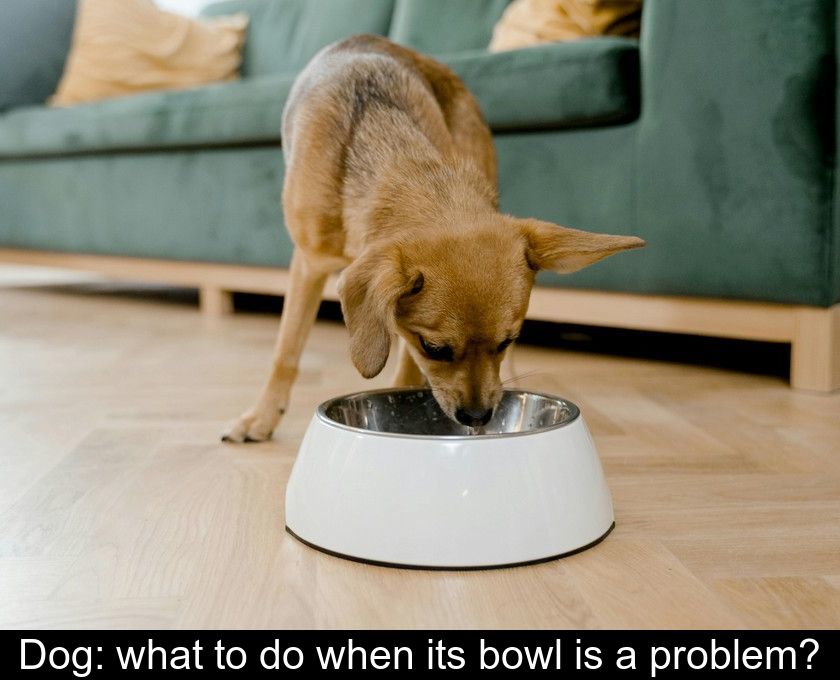Dog: What To Do When Its Bowl Is A Problem?
For pets, mealtime is an important ritual. A dog's bowl should therefore be placed in an accessible part of the house, in a quiet area away from high-traffic zones or other disturbances. However, it sometimes happens that a dog's meal becomes a daily source of concern. We will explain what to do if your dog ignores its bowl, devours it in an instant, or defends it by growling.
1- My dog doesn't finish his bowl.
If you notice that your dog doesn't finish his bowl, observe when he stops eating. Does he interrupt his meal when you leave the room and he's left alone, or conversely, as soon as someone enters the room?
It is important to observe his behavior to better understand the reasons for his loss of appetite. If your dog stops eating when you leave the room, he is likely suffering from hyperattachment. In other words, he needs your company to feel at ease. In this case, it is advisable to place his bowl in a living area, such as the kitchen or the living room, so he can eat in the company of other household members.
Conversely, if your dog stops eating as soon as a human or another dog enters the room, it means that he is anxious to the point of being inhibited by another presence. To help him regain his appetite, it is preferable to place his bowl in a quiet and isolated spot where he can eat in peace.
In both cases, you can encourage the dog to eat by making his meal more appetizing. The trick is to add treat-like ingredients to his usual ration, such as small cubes of cheese or chicken broth.
2- My dog eats from his bowl too quickly.
If your dog is gluttonous every time you give him his bowl, it is not better for his health as he risks indigestion with every meal!
Several tips and tricks can help you address this problem:
• divide his daily ration into two or more meals so that he doesn't swallow a large amount of food in record time.
• opt for an anti-gobble bowl. This is a bowl whose shape is specially designed to make access to the kibble more difficult. This accessory forces the dog to eat more slowly.
• teach him to sit and eat on command.
Regarding the last tip, I am well aware that it is not easy to train your dog on the issue of food. Nevertheless, this training is important to calm your pet's stress or excitement at mealtime and get him used to eating more slowly.
3- My dog defends his bowl by growling.
If your dog bares its teeth and growls when you approach it during its meal, it's simply because it wants to defend its food... It's understandable, but the fact that it protects its bowl from you indicates a lack of trust.
During its meal, it interprets your presence as a threat. This is problematic because your dog could become aggressive and dangerous. Specifically, it could bite your hand when you try to remove its bowl.
To remedy this aggression issue, training is necessary. Ask your dog to sit before placing its meal on the ground. Divide its ration in two to teach it to let you touch its bowl:
• When it has finished the first half of its meal, repeat the command Sit!, then pour the rest of the kibble.
• While it is eating, add a treat like a piece of meat or cheese to its bowl.
Thanks to these tips, your pet will associate your presence with something positive and will no longer be aggressive when you approach it during its meals.
4. His bowl is a source of conflict with other dogs.
If your dog cannot tolerate another dog, even among his best friends, sniffing his bowl, it means that food is a crucial issue for him in his canine social relationships.
Since he is not a sharer, the solution is simple. Never leave his bowl, even empty, available! Remove it as soon as he walks away, even if he hasn't finished his meal. No bowl, no conflict.
If you must have two dogs living together in the same household, make sure that the one who doesn't share doesn't go digging into the other dog's bowl...
A tip to teach them to share meals peacefully is to feed them by scattering their kibble on the ground. This method allows them to learn to search for food, share, and avoid competition.





